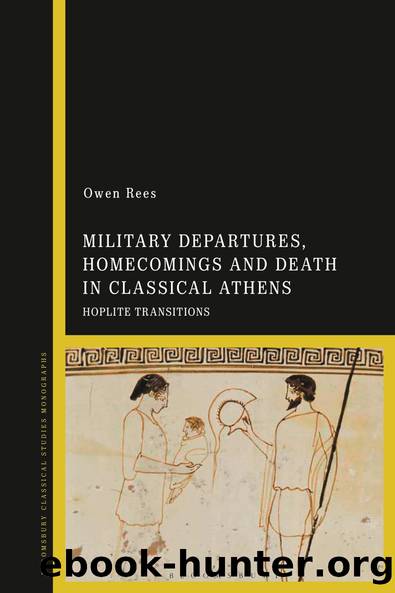Military Departures, Homecomings and Death in Classical Athens by Owen Rees;

Author:Owen Rees; [Неизв.]
Language: eng
Format: epub
ISBN: 9781350188662
Publisher: Bloomsbury UK
Published: 2021-11-09T21:00:00+00:00
Figure 7.2 Relief for the cenotaph of Dexileos. 394/3 BC. Height: 1.75 m. Athens, Kermaeikos Museum: P1130.
The unique element of this inscription is the inclusion of his year of birth: 414/3 BC, during the archonship of Teisandros. It has been noted that the political significance of this information would suggest that its inclusion was to remove the young Dexileos from any association with the oligarchic revolutions of the final decade of the fifth century BC. As a cavalryman, he would have been associated with a pervading stigma, as an obvious member of the aristocracy and part of an institution that was inherently linked with the oligarchy of the Thirty (404/3 BC).69 However, this over emphasis on the political landscape has led Josiah Ober to identify the crushed hoplite in the relief as representing Harmodius, one of the famous tyrant slayers.70 To Ober, it is tempting to read the monument as a âmetaphoric overthrow by the aristocratic cavalryman ⦠of democracy itselfâ.71 This interpretation pushes the imagery too far. He assumes, through the presence of an oinochoe in the grave that depicts the Tyrannicides, that the family intentionally imitated the iconography to portray the hoplite as Harmodius, presuming, in turn, that the family designed every single element of the relief. However, when the inscription is considered alongside the relief and the presence of the one vase, among at least five, then a different interpretation is possible.72
If we consider the emphasis that the inscription places on dating the life and military activity of the young Dexileos, it is clear that the intention was to separate him from the memory of the oligarchies. The presence of the vase showing an historic overthrow of aristocratic tyranny would support this intention; not only was he not associated with the oligarchies, but he was also to be associated with the heroic Tyrannicides no less.73 Yet, it would seem that the relief forms a picture of elite, aristocratic power over the hoplite. How can this dichotomy be reconciled? In effect, by unshackling our interpretations from a political rhetoric, for it is the contrasting political messages which cause the cognitive dissonance. If the monument is seen simply for what it is, a familyâs memorial to a fallen son, then the individual elements begin to make sense.
The Dexileos monument had one important purpose for the family, it allowed them to reinstate his identity. By setting up such a monument they had the opportunity to retake control of his memory. Firstly, they reinstated his patronym, in essence returning him to his family and secondly, they offer him back his personal and social identity by listing his deme. Furthermore, rather than allowing Dexileos to be consumed by the collective war dead and condemned to a list that categorises him as purely a cavalryman during a period of history where this reflected well in Athenian society, the family took quick action. They took pride in his military role, epitomising the aristocratic ideology the family held, so the action in the relief embodies that pride.
Download
This site does not store any files on its server. We only index and link to content provided by other sites. Please contact the content providers to delete copyright contents if any and email us, we'll remove relevant links or contents immediately.
Spare by Prince Harry The Duke of Sussex(4800)
Machine Learning at Scale with H2O by Gregory Keys | David Whiting(3654)
Fairy Tale by Stephen King(2962)
Will by Will Smith(2589)
Hooked: A Dark, Contemporary Romance (Never After Series) by Emily McIntire(2428)
The Bullet Journal Method by Ryder Carroll(2405)
Rationality by Steven Pinker(2156)
It Starts With Us (It Ends with Us #2) by Colleen Hoover(2053)
Friends, Lovers, and the Big Terrible Thing by Matthew Perry(2013)
Can't Hurt Me: Master Your Mind and Defy the Odds - Clean Edition by David Goggins(2008)
The Becoming by Nora Roberts(1926)
Love on the Brain by Ali Hazelwood(1824)
HBR's 10 Must Reads 2022 by Harvard Business Review(1702)
The Strength In Our Scars by Bianca Sparacino(1701)
A Short History of War by Jeremy Black(1677)
Leviathan Falls (The Expanse Book 9) by James S. A. Corey(1530)
515945210 by Unknown(1524)
Bewilderment by Richard Powers(1454)
443319537 by Unknown(1400)
